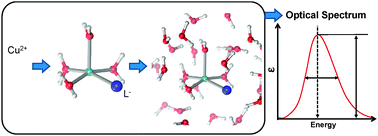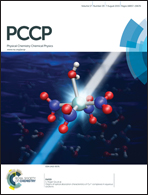Origins of optical absorption characteristics of Cu2+ complexes in aqueous solutions†
Abstract
Many transition metal complexes exhibit infrared or visible optical absorption arising from d–d transitions that are the key to functionality in technological applications and biological processes. The observed spectral characteristics of the absorption spectra depend on several underlying physical parameters whose relative contributions are still not fully understood. Although conventional arguments based on ligand-field theory can be invoked to rationalize the peak absorption energy, they cannot describe the detailed features of the observed spectral profile such as the spectral width and shape, or unexpected correlations between the oscillator strength and absorption peak position. Here, we combine experimental observations with first-principles simulations to investigate origins of the absorption spectral profile in model systems of aqueous Cu2+ ions with Cl−, Br−, NO2− and CH3CO2− ligands. The ligand identity and concentration, fine structure in the electronic d-orbitals of Cu2+, complex geometry, and solvation environment are all found to play key roles in determining the spectral profile. Moreover, similar physiochemical origins of these factors lead to interesting and unexpected correlations in spectral features. The results provide important insights into the underlying mechanisms of the observed spectral features and offer a framework for advancing the ability of theoretical models to predict and interpret the behavior of such systems.


 Please wait while we load your content...
Please wait while we load your content...